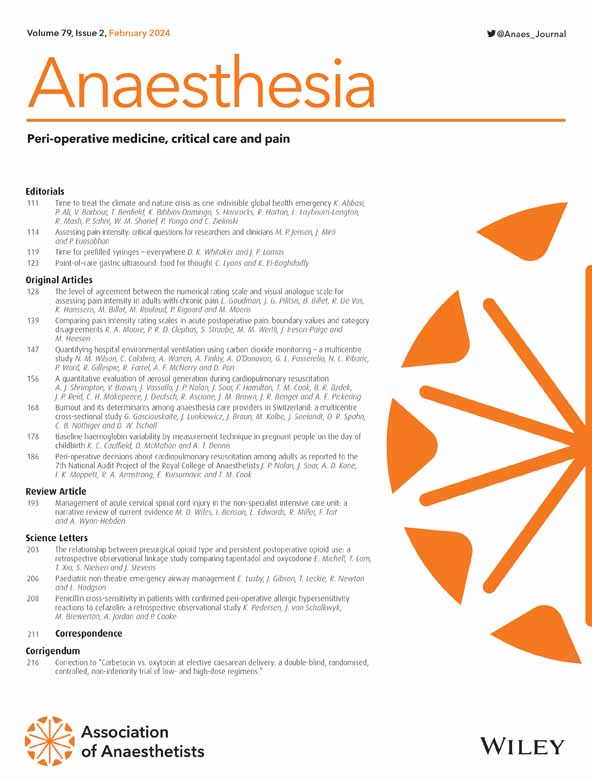Global anaesthesia practice using inguinal hernia surgery as a tracer condition: a secondary analysis of an international prospective cohort study.
IF 6.9
1区 医学
Q1 ANESTHESIOLOGY
引用次数: 0
Abstract
INTRODUCTION Restoration of surgical capacity is essential to post-COVID-19 recovery. This study explored the use and safety of anaesthesia options for inguinal hernia surgery, a common tracer condition, to describe current global practice and highlight opportunities to build the capacity of health systems. METHODS This is a secondary analysis of an international prospective cohort study of consecutive patients who underwent elective inguinal hernia surgery. We used a consensus process to define generalisable outcomes to measure patient selection, utilisation of hospital capacity and peri-operative safety in patients who received locoregional, spinal or general anaesthesia for their surgery. RESULTS In total, 16,554 patients from 83 countries were included. Locoregional anaesthesia was performed in 1536 (9.2%) of patients, compared with 9165 (55.4%) who had general and 55,853 (35.4%) who had spinal anaesthesia. Patient selection outcomes were comparable across anaesthesia groups. As a measure of hospital capacity, adjusted day-case rates were higher for locoregional anaesthesia (OR 6.62, 95%CI 5.13-8.54, p < 0.001) but not for spinal anaesthesia (OR 0.97, 95%CI 0.84-1.12, p = 0.68) compared with general anaesthesia. Complications were lower in patients who underwent locoregional anaesthesia (OR = 0.67, 95%CI 0.52-0.87, p = 0.001) but not for spinal anaesthesia (OR = 0.90, 95%CI 0.77-1.05, p = 0.167) compared with general anaesthesia after risk adjustment. DISCUSSION This study has filled knowledge gaps of anaesthesia practice in common surgeries across the world. Locoregional and spinal anaesthesia could be adopted as safe options to increase surgical volume when there is limited access to general anaesthesia.使用腹股沟疝手术作为示踪条件的全球麻醉实践:一项国际前瞻性队列研究的二次分析。
手术能力的恢复对于covid -19后的恢复至关重要。本研究探讨了腹股沟疝手术麻醉选择的使用和安全性,这是一种常见的示踪疾病,以描述当前的全球实践,并强调建立卫生系统能力的机会。方法:这是一项对连续接受择期腹股沟疝手术患者的国际前瞻性队列研究的二级分析。我们使用共识过程来定义可推广的结果,以衡量在手术中接受局部麻醉、脊髓麻醉或全身麻醉的患者的患者选择、医院容量利用率和围手术期安全性。结果共纳入83个国家的16554例患者。1536例(9.2%)患者接受了局部区域麻醉,9165例(55.4%)患者接受了全身麻醉,55,853例(35.4%)患者接受了脊髓麻醉。不同麻醉组的患者选择结果具有可比性。作为衡量医院容量的指标,与全身麻醉相比,局部区域麻醉的调整日病例率更高(OR 6.62, 95%CI 5.13-8.54, p < 0.001),而脊髓麻醉的调整日病例率则不高(OR 0.97, 95%CI 0.84-1.12, p = 0.68)。风险调整后,与全身麻醉相比,局部区域麻醉患者的并发症较低(OR = 0.67, 95%CI 0.52-0.87, p = 0.001),而脊髓麻醉患者的并发症较低(OR = 0.90, 95%CI 0.77-1.05, p = 0.167)。本研究填补了世界各地普通手术麻醉实践的知识空白。当全身麻醉有限时,可以采用局部和脊髓麻醉作为增加手术量的安全选择。
本文章由计算机程序翻译,如有差异,请以英文原文为准。
求助全文
约1分钟内获得全文
求助全文
来源期刊

Anaesthesia
医学-麻醉学
CiteScore
21.20
自引率
9.30%
发文量
300
审稿时长
6 months
期刊介绍:
The official journal of the Association of Anaesthetists is Anaesthesia. It is a comprehensive international publication that covers a wide range of topics. The journal focuses on general and regional anaesthesia, as well as intensive care and pain therapy. It includes original articles that have undergone peer review, covering all aspects of these fields, including research on equipment.
 求助内容:
求助内容: 应助结果提醒方式:
应助结果提醒方式:


